Kristin used to hang out on Capri and the Costiera Amalfitana, in the old days, but we've never been, and it's time. So here we go for a couple of weeks in fall 2010 for the off-season prices.
You
may not find this terribly rewarding unless you're included here, so this
is a good time for casual and random browsers to turn back before they
get too caught up in the sweep and majesty of the proceedings and can't
let go.
Ravello, home of the stars
We've got off the EasyJet without mishap in Naples, hired a car from a nice young gentleman at the airport, and Kristin got us out of the city and over the Latari mountains at dusk, vertiginously down to Ravello poised above the Amalfi coastline.

The view from our room in the Garden hotel/ristorante, great value at least at off-season prices, very nice people.
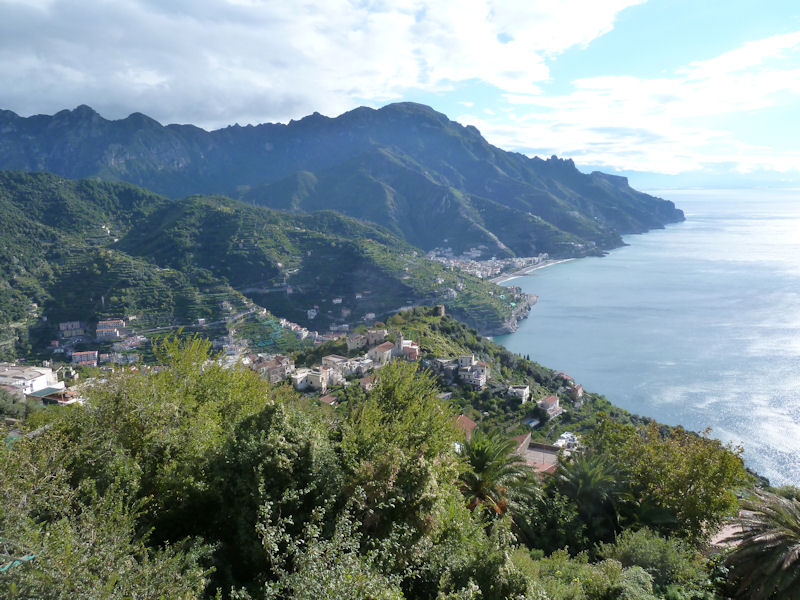
We're looking down on Minori in the foreground, and Maiori tucked into the little bay, and the modestly horrifying coastal road winding round that point to Salerno 30km down the way.

A Lumix-zoom on the church in Minori, even better all lit up at night

The breakfast room in the Garden hotel. The Garden is privately owned but it's tucked in on the hillside adjacent to the famous gardens of the Villa Rufolo alongside.

Our first venture out, a blustery day -- this is the village square from the front stoop of the Cathedral of St Pants. Who knows when Ravello was first settled in its mountain eyrie, 350m over the sea, but it was developed in the 9th century as one of Amalfi's two dependent towns, and by the 13th century it had become a major resort for the great and the good of Amalfi in the summer months.

Tourism is important here, and Ravello has long been a celebrity haunt -- Boccaccio set bawdy love tales of the Decameron here, in the mid-14th century, and by the late 19th century no famous artist, musician, or writer seems to have missed it.

For example (here comes the obligatory list, abbreviated): Richard Wagner worked on Parsifal here and famously modeled the magic garden of Klingsor on the gardens of the Villa Rufolo; Liszt worked here; André Gide wrote The Immoralist whilst living here in 1902, and Forster worked here in 1928 in the same house. Virginia Woolf and many of the Bloomsbury group haunted the place, and D. H. Lawrence wrote Lady Chatterley's Lover in a house on the walk up to the Villa Cimbrone.

The village square, in front of the Duomo, on a brighter day during our visit. Most interesting of all, to us: Gore Vidal lived part of many years here until the years caught up with him, and he sold his villa La Rondinaia in 2003. He's evidently much loved here -- a local resident only lamented that he had not donated his villa to the town, since she feels that it's gone downhill since he left.

The Piazza Duomo

The Duomo, with artisanal ceramic shops, tea rooms, and boutiques built into the porch.

The Duomo, dedicated to St Pantaleone, was begun in 1086, and its famous bronze front doors date from 1179. It really is a cathedral, there was always a bishop seated here, though the village, at least at present, has only about 2,500 residents.

Aside from the bronze doors, there are two more famous features: this is the "Arabo-Byzantine" pulpit, or ambo, with six spiral mosaic columns supported by lions, paid for by the Rufolo banking dynasty in 1272.

Another ambo, depicting Jonah and the Whale (an allegorical afterlife theme), dates from a century earlier.

I don't recall if this gentleman was napping in the cathedral of St Pants or in another spiritual facility nearby. St Pantaleone's blood (kept in a vial) liquifies from time to time (every 27 July has been mentioned, amongst other dates) in remembrance of his slo-mo martyrdom in A.D. 305. (This is not an uncommon edifying phenomenon -- the clever lads of the medieval tourist bureau used to mix up an iron hydroxide solution that would liquify on command when shaken.)
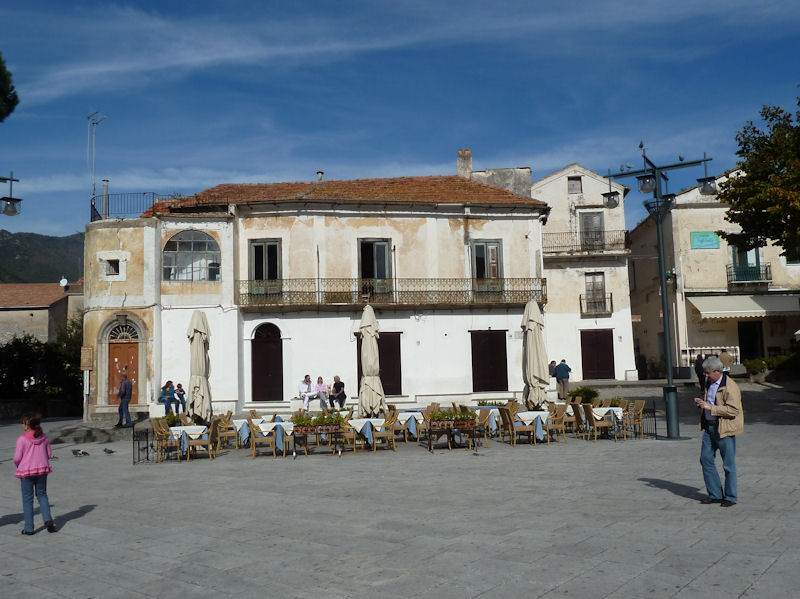
Martyring Pantaleone was not easy: The Emperor Diocletian condemned him when he would not abjure, but burning him with torches didn’t work. Neither did a bath of molten lead, and the stone they tied him to when they threw him into the sea floated. The wild beasts to which he was fed demurred, and the wheel on which he was tied to be broken broke. The sword broke, too, when they tried to behead him, but he finally decided to give the martyrers a break and let them finish it up. He’s a patron saint of physicians, having been one, and his head is apparently in Lyon, France.

Much of Ravello is blessedly pedestrian -- there's even a new automobile tunnel that runs under the village to connect the Latari mountain road with the road to Amalfi on the coast.

Some of the shops run along passageways underneath the buildings.

Santa Maria a Gradillo, 11th century Romanesque, very nice

Santa Maria a Gradillo from the other side

Kristin's looking all about for the hotel she stayed in in a former incarnation.

Up the hill above the Duomo, the Via San Giovanni del Toro runs up to the church of that name.

On the Via San Giovanni del Toro

The Via San Giovanni del Toro

San Giovanni del Toro, a Romanesque church from the 1060s, with an Arab-Sicilian bell tower and lots of stuff inside that we didn't see because it was closed.

From a high point near the church of Giovanni del Toro, we're looking up at Ravello suburbs and the Latari mountain massif.

Another side of Ravello

Kristin and the police

The Villa Rufolo across the way, as we're trudging upward to the other great garden attraction, the Villa Cimbrone.
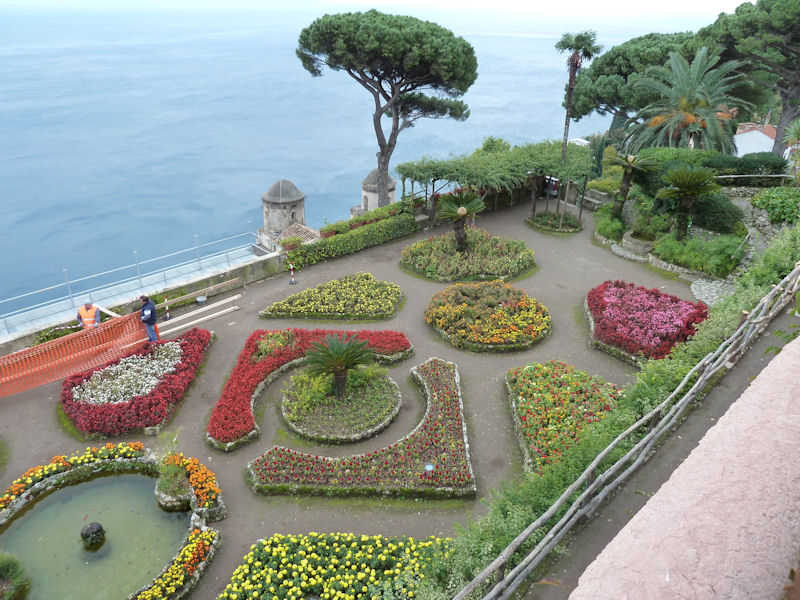
These are some of the famous Wagnerian gardens of the Villa Rufolo, which we visited yesterday.

On our walk out to the Villa Cimbrone, that's Amalfi's other traditional satellite town, Scala, a kilometre or so away on the next ridge.

Scala with the zoom on

The entrance courtyard of the Villa Cimbrone, an originally 11th century sprawling edifice that was much-modified over time and then vastly elaborated in the early 20th century by Lord Grimthorpe, who sounds like someone out of Gormenghast and Titus Groan but was just a British banker and member of Parliament.

Cimbrone is operated now as an upscale hotel and restaurant, but the extensive Grimthorpian gardens are open to the public, like this strange classicism at the far end of the ridge overlooking the sea at the so-called Belvedere.

Awful busts ornament the Belvedere Cimbrone, 340 meters over the Gulf of Salerno. Ernest Beckett, the 2nd Lord Grimthorpe, may have owed his talent to his father Edmund, the first Lord Grimthorpe, the man who designed the Big Ben clock at Westminster, who for his restoration work on St Albans Cathedral bequeathed the verb "to grimthorpe", to carry out wrongheaded improvements on some ancient building that wasn't doing all that badly anyway.

Scala from the Belvedere. Gore Vidal is said to have described the view from this Belvedere on a bright winter's day as the most beautiful he'd seen in his travels.

A competition of noses on the Belvedere Cimbrone.

Kristin rubbing Mercury's toes, to bring good luck, or fleet-footedness, or an unstable personality, or something.

His Lordship's now-dilapidated Temple of Bacchus, with happy nudies. (Shh, Lord Grimthorpe is sleeping underneath that thing.)

Smoke drifting over Scala
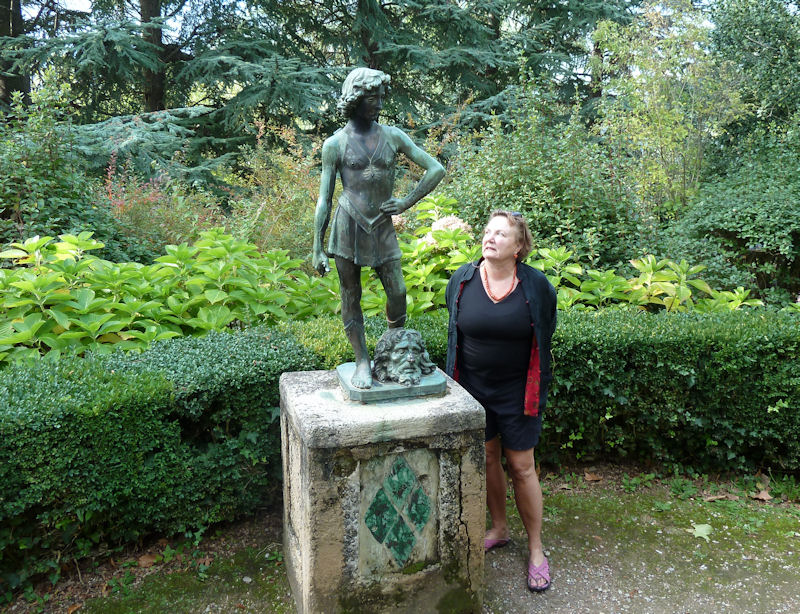
Kristin and a creepy little David with his Goliath souvenir
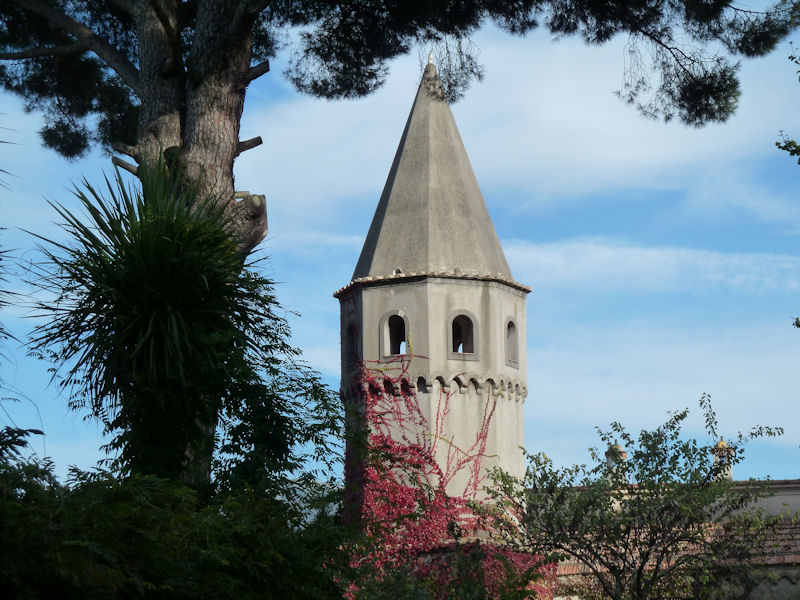
Villa Cimbrone

The courtyard of the Villa Cimbrone residential/hotel part

The walkway back along the rocky ridge to Ravello from the Villa Cimbrone

Walking back into Ravello. D. H. Lawrence lived here (thus the plaque on the wall). And he wrote Lady Chatterley here -- a few years ago we stumbled upon the rustic inn in Zennor where he wrote Women in Love; coincidence?

The Duomo in afternoon sunlight

Over to the shops at the end of the day to lay in a little something for the hotel room in the evening.

Late afternoon. Tomorrow we're going to brave the coast road past Salerno to visit Paestum, for the Greek temples, etc.

Like this one. That's all here.

And now, after Paestum, we're back, with a last look at the Villa Rufolo from the Piazza Duomo. Tomorrow we'll have to move on.

The restaurant and terrace of the Garden hotel. Very happy here. Now for some more of the harrowing coast road, through Positano, to the ferry from Sorrento to Capri.

The modern patron saint of Ravello










